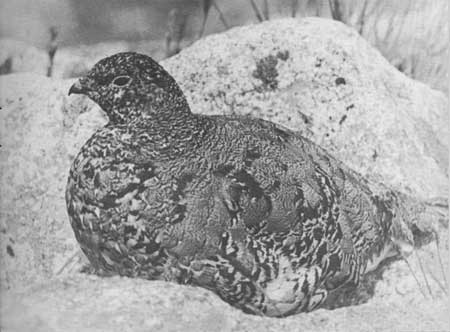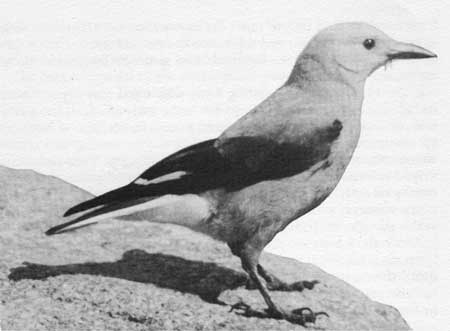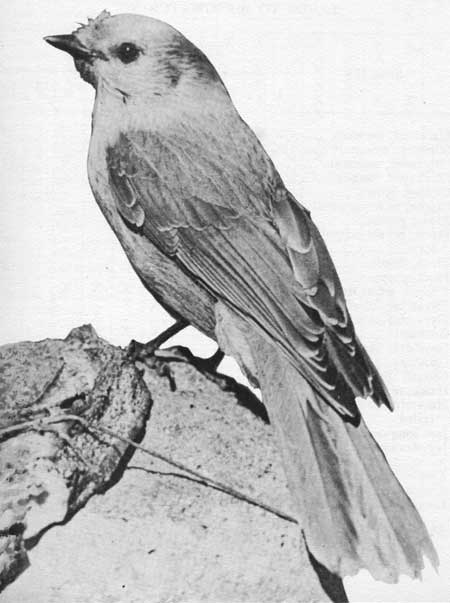|
ROCKY MOUNTAIN National Park |
 |
Animal Life (continued)
BIRDS
With over 250 different species listed in the most recent publication on local birds, it is difficult to give adequate attention to the subject in the limited space of this handbook. Park birds, like our human population, can be classified as visitors and residents. Some birds, en route to other nesting areas, visit the park for only a few days; some remain a month or two; many are permanent residents. Occasionally a "Straggler" appears, far from its usual haunts. Birds, like human visitors to the park, can be further classified by their preferences as to locale. As some tourists prefer to visit the high peaks and lofty tundra areas, so some birds prefer these areas. A few people come here only to fish; the belted kingfisher does so, too. Like most humans, many birds may be seen almost anywhere in the park, and the greatest variety and population of birds occur in the summer season.
A number of park birds—both permanent and migratory—have specific preferences. For instance, if a bird's diet is mostly seeds from pine cones, it will usually be found in pine forests, and if it has become adapted to the Arctic tundra region—perhaps from ancestors in an earlier time—it will today remain there. Typical park environments and the characteristic bird life of zones are outlined on pages 50 and 51. Most of the birds breed in these associations.
The lower altitudes of the park—ponderosa pine forests and grassy meadows—have a large and varied population of birds during the summer. Here lives the LONG-CRESTED JAY, easily recognized by its rich-blue wings, sharp crest, and saucy manner. The MAGPIE is a member of the jay family with conspicuously long tail, large greenish irridescent black and white body, and propensity for scavenging small animals killed by autos. The NATALIE'S SAPSUCKER is always associated with the ponderosa pine, pecking its sap-holes; and the RED-NAPED SAPSUCKER, with its bright-red throat and crown, usually is seen working on aspens. The GREEN-TAILED TOWHEE nests in the shrubs of the Montane Zone during June. RED-EYED VIREOS are found in the forested valleys from June into August and are characterized by the gray cap and black-bordered white stripe over the eye. The PYGMY NUTHATCH, a tiny, noisy bird, with a brown head and white underparts, wanders in small flocks through the pine forests in spring and fall calling noisily, but scatters during the nesting season. There is some migration of pigmy nuthatches to the plains when winter comes. The chickadees, both the MOUNTAIN CHICKADEE, which remains in the park during the winter and has a typical black cap, broken by a white line above the eye, and the completely black-capped LONG-TAILED CHICKADEE, which becomes scarce in the winter, belong in the Montane Zone. The VIOLET-GREEN SWALLOW is an abundant species in this zone. The MOUNTAIN BLUEBIRD arrives in "waves" during April, to leave scattered pairs to nest in holes in aspens or other cavities. This species lacks the rufous breast, but has the characteristic azure color its name suggests. The WESTERN TANAGER, the most colorful bird in the park, is mainly black and yellow with a red face. It arrives in the park in mid-May and leaves during August.
Also nesting in this general zone, but in rocky cliffs and canyons, is the rare GOLDEN EAGLE (empty nests have been found, and a few sight observations are made every summer); the CANYON WREN, never numerous, but its characteristic "laughing" song is often heard during May and June; and the WHITE-THROATED SWIFT, which arrives early in May to nest in crannies in the cliffs at the very east edge of the park, only to leave in June.
In the lodgepole and aspen forests from about 8,500 feet upward, other birds generally prefer to nest and are relatively common. These include the WOOD PEWEE, with a dark-gray back, dull-gray underparts, and two white bars on the long wings; the WARBLING VIREO, a migrant which arrives in a wave late in May; the LINCOLN'S SPARROW, streaked, with a short tail, which spends only 2 months in the park; the RUBY-CROWNED KINGLET, which appears suddenly in late April and fills the forests with its song during June; the showy AUDUBON'S WARBLER, with its bright-yellow throat; and the AUDUBON'S HERMIT THRUSH, the songs of which ring through the lodgepole and spruce-fir forests and along the streams through July.
In the spruce-fir forest, nesting birds which you may expect to see include the PINE GROSBEAK, a large finch, the male of which has a rich rose-red head; and the BROWN CREEPER, named for its habit of creeping up tree trunks. Thickets near timberline are the nesting area of the WHITE-CROWNED SPARROW, a bird with strikingly black-and-white striped crown. It is as much at home above timberline as below, usually ready to scold all hikers who invade its territory. The PILEOLATED WARBLER, with yellow body and black cap, nests in the willows at this altitude, but leaves the heights in August and returns in May.
 THE PTARMIGAN'S SUMMER COAT RESEMBLES LICHEN-COVERED BOULDERS OF THE HIGH MEADOWS WHERE IT LIVES. —Fish and Wildlife Service photo. |
Above the forests, on the wind-swept tundra, are some of the most interesting birds of the park. Here the WHITE-TAILED PTARMIGANS spend the entire year. These alpine grouse, mottled-brown in summer, become pure white in midwinter. They assemble in small flocks in September to spend the winter together, but disperse during May and June for courtship and to raise a family. Nesting ptarmigans have been seen close by the busy Trail Ridge Road. Depending upon their natural camouflage for protection, they seldom act alarmed when closely approached. Ornithologists travel far to see the BROWN-CAPPED ROSY FINCHES which occur only in Colorado and immediate regions. Nesting in the cliffs above timberline during summer, these birds band together in autumn to descend into the ponderosa forests for the winter. A third common bird of the tundra is the ROCKY MOUNTAIN PIPIT, a small ground bird. The tail, which shows white outer feathers, is almost constantly in wagging motion. Pipits have an interesting courtship flight and during midsummer are seen only above timberline, where they nest. By late August they descend to the lower altitudes, not to return until June.
 CLARK'S NUTCRACKER, FAMILIAR AT THE PARKING AREAS, OFTEN CONFUSED WITH THE "CAMP ROBBER," OR ROCKY MOUNTAIN JAY. —Clark Blickensderfer photo. |
Even the most casual visitor notices the "camp robber" and its "cousin," the CLARK'S NUTCRACKER. These members of the jay family are common at Bear Lake and at Many Parks and Rainbow Curve parking areas on Trail Ridge Road, where they compete with the chipmunks for handouts from the motorists. The "camp robber," known as the ROCKY MOUNTAIN JAY, is the local race of the CANADA JAY, with dull-gray body, lighter-gray head, and a shorter bill than the Clark's nutcracker, with which it is usually seen. The larger gray-bodied nutcracker has distinctly black wings and tail and large white patches. It tends to range both above timberline and down into the ponderosa pine belt during the summer, whereas the "camp robber" has a more restricted distribution. The AMERICAN RAVEN is often seen soaring over the canyons. RED-TAILED HAWKS are fairly common—those which nest on the cliffs southeast of the museum are almost always to be seen in Moraine Park during the summer. The WESTERN ROBIN is abundant and widely distributed in the park during the summer. Flocks of robins are to be seen above timberline into October. The sleek BOHEMIAN WAXWING passes through the park in winter. Along the beaver ponds, in the willows, the showy THICK-BILLED REDWING may be seen from May until July.
 ROCKY MOUNTAIN JAY, OR "CAMP ROBBER," WHICH OFTEN VISITS THE TOURISTS DURING LUNCH STOPS. —Clark Blickensderfer photo. |
Possibly the most unusual bird of the park is the WATER OUZEL, or DIPPER, which is seen only near a rushing mountain stream or waterfall. This is a chunky little dark-gray bird, with a habit of bobbing up and down constantly. It hops into rushing water in search of aquatic insects—an apparently suicidal method of food-gathering that does it no harm. The mossy, dome-shaped nest is usually built where spray can keep it moist. You might see one of these amazing creatures at Chasm Falls, at The Pool, along Mill Creek, or in some of the cascades in Wild Basin.
It is hoped that this brief treatment of the birds will arouse your interest in these important members of the park's wildlife. Naturalist-conducted bird hikes are scheduled during the summer, and an assortment of bird books is on sale at Moraine Museum. Birds are an important element in the enjoyment of the park, and you are invited to take advantage of the opportunity to become acquainted with them.

|

|
|
|
|
Last Modified: Sat, Nov 4 2006 10:00:00 pm PST |


